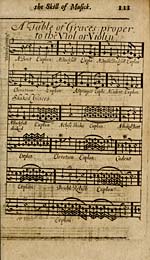Inglis Collection of printed music > Printed text > Introduction to the skill of musick
(130) Page 110
Download files
Complete book:
Individual page:
Thumbnail gallery: Grid view | List view

no An Introduction to
Thirdly, For true fingering , obferve thefe di-
rections , which will appear more eafie to yot
underftanding , if in your firfl practice you hat
your Violin Fretted, as is before mentioned, thjl
where you skip a fret or fiop , there to leave
Finger } for every fiop is but half a Tone or Notj
for from Jx to X is but half a Note , but froi
Jb. to j£. is a whole Note \ therefore the leavij}
of a Finger is neceflary to be in readinefs whf
half Notes happen, which is by flats and Sharps.
Fourthly, When you have any high Notes, whi^
reach lower than your ufual Frets or Stops, the!
you are to fhift your fingers j if there be but tv<
Notes , then the firfl is ftopt with the fecond fingej
and the reft by the next fingers.
Fifthly, In the moving your Bow up and dov?
obferve this Rule , when you fee an even numb^
of Quavers and Semiquaver.'; , as 2, 4, 6 or 8 tye
together, your Bow muft move up, though,
was up at the Note immediately before, but if yi
have an odd number, as 3, ^, or 7, (which happe
very often , by reafon of a prickt Note or an oi
Quaver Reft) there your Bow muft be drawn dowt
wards at the firft Note.
Laltly , In your pra&ice of any LeiTon , pis
it flow at firft, and by often practice it will Wi
your hand to a more fwift motion.
As for the feveral Graces and Flourifl:es that as
11 fed , as 5 hakes , Backfalls , and double Relives , tlj
following Table will be fome help to your pradti
for there is firft the Note plain , and after
Grace exprefled by Notes at length-
Thirdly, For true fingering , obferve thefe di-
rections , which will appear more eafie to yot
underftanding , if in your firfl practice you hat
your Violin Fretted, as is before mentioned, thjl
where you skip a fret or fiop , there to leave
Finger } for every fiop is but half a Tone or Notj
for from Jx to X is but half a Note , but froi
Jb. to j£. is a whole Note \ therefore the leavij}
of a Finger is neceflary to be in readinefs whf
half Notes happen, which is by flats and Sharps.
Fourthly, When you have any high Notes, whi^
reach lower than your ufual Frets or Stops, the!
you are to fhift your fingers j if there be but tv<
Notes , then the firfl is ftopt with the fecond fingej
and the reft by the next fingers.
Fifthly, In the moving your Bow up and dov?
obferve this Rule , when you fee an even numb^
of Quavers and Semiquaver.'; , as 2, 4, 6 or 8 tye
together, your Bow muft move up, though,
was up at the Note immediately before, but if yi
have an odd number, as 3, ^, or 7, (which happe
very often , by reafon of a prickt Note or an oi
Quaver Reft) there your Bow muft be drawn dowt
wards at the firft Note.
Laltly , In your pra&ice of any LeiTon , pis
it flow at firft, and by often practice it will Wi
your hand to a more fwift motion.
As for the feveral Graces and Flourifl:es that as
11 fed , as 5 hakes , Backfalls , and double Relives , tlj
following Table will be fome help to your pradti
for there is firft the Note plain , and after
Grace exprefled by Notes at length-
Set display mode to: Large image | Transcription
Images and transcriptions on this page, including medium image downloads, may be used under the Creative Commons Attribution 4.0 International Licence unless otherwise stated. ![]()
| Special collections of printed music > Inglis Collection of printed music > Printed text > Introduction to the skill of musick > (130) Page 110 |
|---|
| Permanent URL | https://digital.nls.uk/94576904 |
|---|
| Description | Scottish and English songs, military music and keyboard music of the 18th and 19th centuries. These items are from the collection of Alexander Wood Inglis of Glencorse (1854 to 1929). Also includes a few manuscripts, some treatises and other books on the subject. |
|---|
| Description | The Glen Collection and the Inglis Collection represent mainly 18th and 19th century Scottish music, including Scottish songs. The collections of Berlioz and Verdi collected by bibliographer Cecil Hopkinson contain contemporary and later editions of the works of the two composers Berlioz and Verdi. |
|---|

